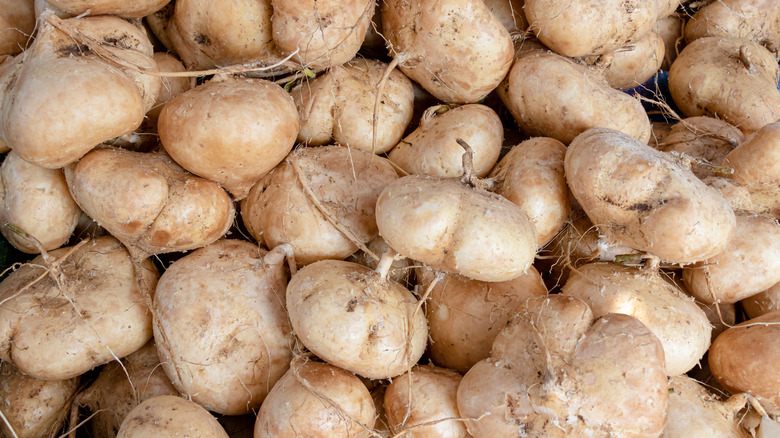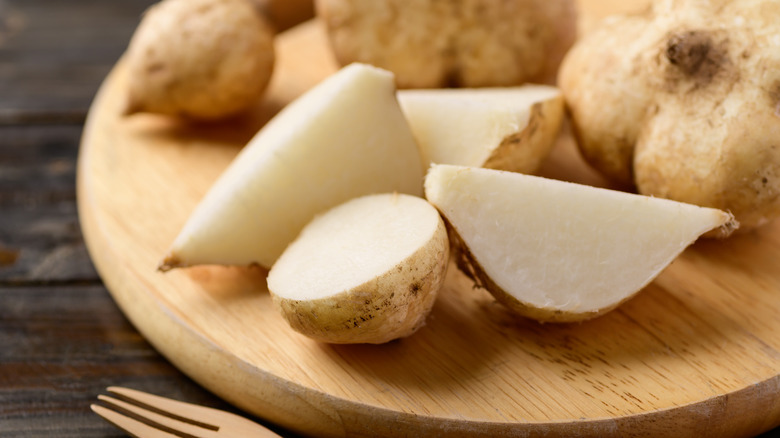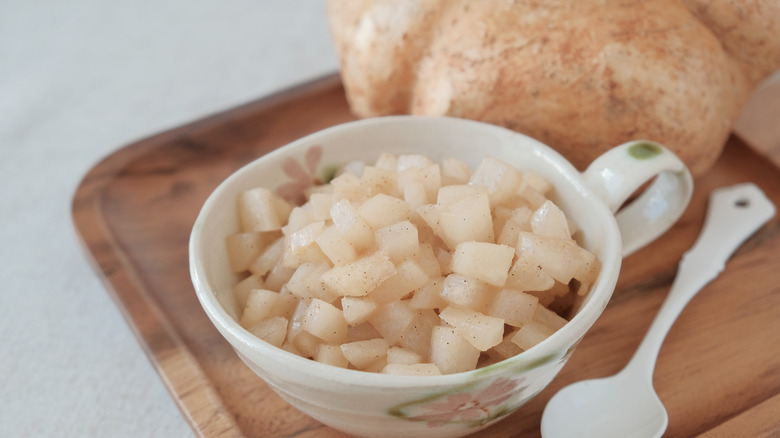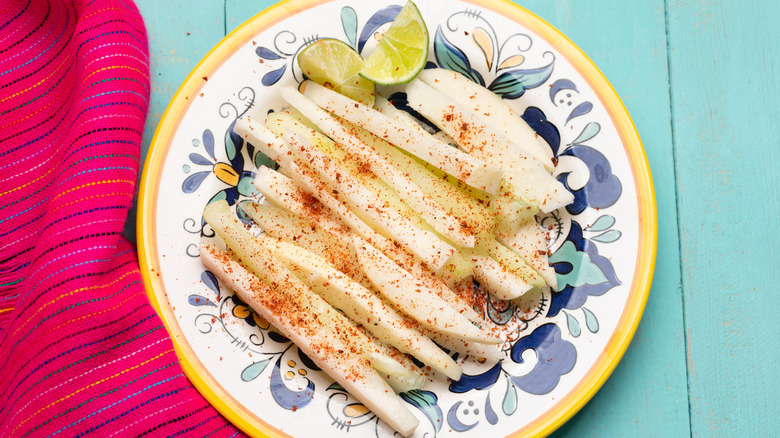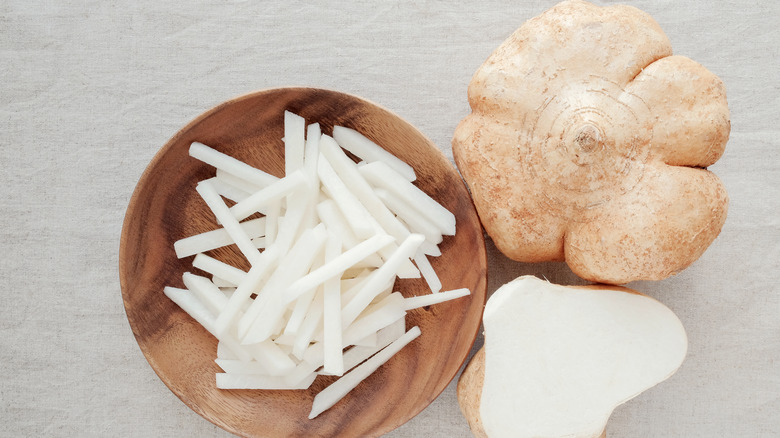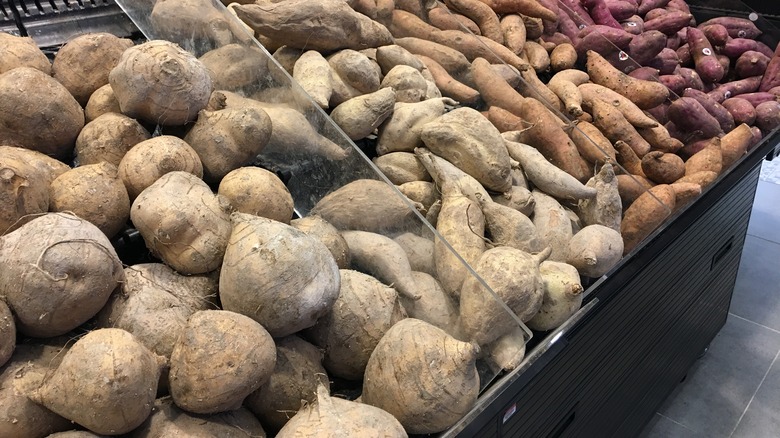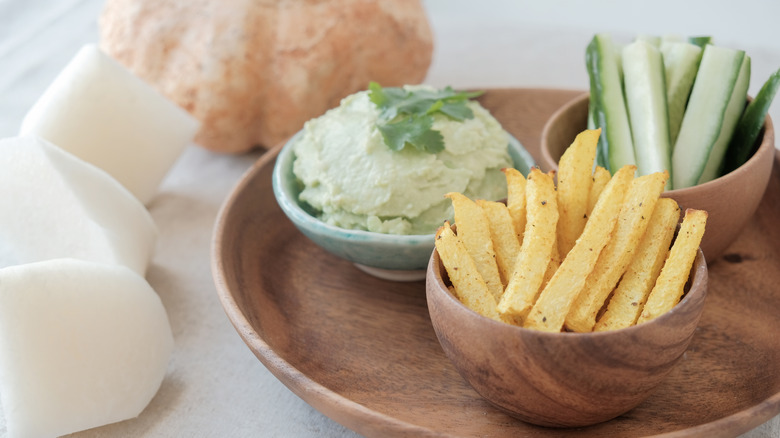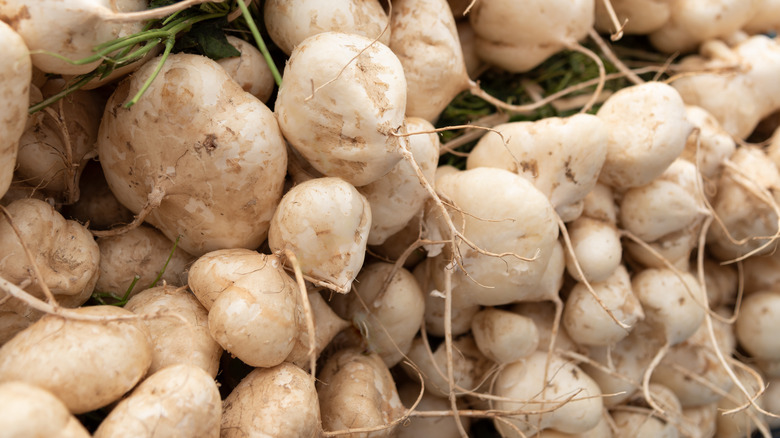What Is Jicama And How Do You Eat It?
When shopping for produce, it's easy to get stuck grabbing the usual suspects, without taking the time to explore new options. Since vegetables don't usually come with instructions, reaching for a turnip or potato might be more natural to you than picking up a jicama (Pachyrhizus erosus). According to Specialty Produce, the botanical name translates to thick root in Greek, which makes sense when you catch sight of it. While jicamas generally hang out with other starchy root vegetables and have alternate names reflecting the similarities (Mexican potato, yam bean, Chinese turnip), the texture is unlike most. Crunchy, crispy, and juicy, jicamas are considerably refreshing compared to many roots and are often eaten raw.
The texture and the mild flavor profile makes jicama a versatile option to add to a variety of dishes. You don't need any fancy preparations to include it in your cooking, and you can even stick to eating it raw if you want a minimal effort option. Jicama packs in plenty of nutrients and health benefits, which is why you'll surely want to incorporate it into your diet.
What is jicama?
Originally from Mexico, Food Print explains that the Spanish brought jicamas to the Philippines in the 16th century, where they soon ended up in Indonesia, China, and West Africa. The source indicates that the vegetable was mentioned in Mayan manuscripts and was praised by the Aztecs, who named it xicama in the Nahuatl language. Nowadays, most jicamas in the United States' market come from Mexico, though warmer states such as Texas, Florida, and Hawaii also grow it according to Food Print.
Although only the root is edible, the rest of the plant grows as a vine with beans and is a member of the legume family (Fabaceae), notes Lybrate. Surprisingly, though jicamas look similar to potatoes, they're actually more closely related to chickpeas, green beans, and black beans.
Jicamas are rounded, with slightly flattened ends and light brown golden tinged skin. The skin's texture is similar to rutabagas and turnips, and depending on maturity, it can be thinner like paper, or closer to bark. The interior flesh is white, juicy, and crunchy. On average, jicamas are 2 to 3 pounds, but Food Revolution reports there are some that make it to 50 pounds. Larger isn't better when it comes to jicamas, and the oversized ones tend to be fibrous.
To protect it against natural predators, Britannica explains that the stems, leaves, and seeds contain rotenone, often used in insecticide. It is definitely toxic to humans, so be sure to stick to eating the crunchy white flesh.
Fresh jicama vs. cooked jicama
Unlike many roots, jicama is delicious eaten raw, although it is versatile and can also be cooked for a different texture and profile. Fresh jicama is often sold by street vendors as a crunchy snack, paired with lime or lemon juice and powdered chili. The raw vegetable is firm and can easily be shredded into a salad much like carrots, to add a refreshing and texturally satisfying component. Wherever you decide to include raw jicama, you'll be adding some crisp and a sweet, mildly nutty flavor.
Meanwhile, cooked jicama loses its characteristic crunch if it is heated longer than a quick stir-fry. Nevertheless, it can still be used to make delicious preparations, such as by adding it to soup, making a mash, or turning it into fries. If you cut it thinly enough and bake it, you can even make crispy chips. For people who are sensitive to food heavy in fiber, cooking jicama can facilitate its digestion.
What does jicama taste like?
Jicama is so versatile partly because it doesn't have an intense flavor profile. It is mildly nutty with a touch of sweetness, though the larger ones will have less flavor and won't be as sweet. Since the water content is so high, it is especially refreshing, altering the sensorial components of a dish along with its crunchy texture. It is often described as a cross between a potato and a crisp pear or apple, as well as similar to a water chestnut. Though it is a starch, its high water content sets it apart from other root vegetables.
If you choose to cook jicama, it is common to season it. Additionally, it will readily absorb the other flavors in the dish. This makes it a great candidate for spice rubbed fries or to thicken soups. The texture won't be as crunchy or watery, so it definitely takes on a different allure depending on whether you eat it raw or cooked.
How to cook with jicama
A great quality about jicama is that it can be baked, boiled, steamed, fried, sautéed, eaten raw, you name it. In all cases, first things first, it is important to remove the skin since it contains rotenone, a toxic compound. A sharp peeler or knife should do the trick, though larger jicamas might have a thin layer under the skin to remove as well. While supermarkets will only sell the edible root, if you are growing it yourself, you will want to dispose of the leaves, stem, and seeds.
For thin slices, to make chips for example, use a mandoline. Another recommendation includes cutting jicamas into matchsticks and adding them to spring rolls for a refreshing crunch. You could serve them in a crudite platter with hummus or another dip. Some sources note that the mild vegetable pairs really well with fresh herbs, avocado, and citrus, which you can combine to make a shredded jicama salad. We're also keen to try the recommendation to pickle it or make a relish.
If you plan to add it to a stir-fry, dice it or cut it into sticks for fries. Finally, if you're going to boil it to a mash or for soup, chunks will work fine. For a fun twist on a fruit salad, throw some jicama in — the mild nutty sweet flavors will add an exotic touch.
Where to buy jicama
Thankfully, as more consumers are willing to experiment with food that isn't always familiar, jicamas can be found year-round in most supermarkets in the produce aisle. Depending on where you live, you may have a better chance finding them from October to May, at their peak, explains Food Reference. If you have access to a Latin American or Asian specialty shop, you should be able to find them in these spots as well. They're usually sitting alongside turnips, rutabagas, and the like. If you want a quick option to add to a salad or crudité platter, Eating Bird Food reports that Trader Joe's sells bags of peeled and chopped jicama.
As far as choosing jicamas to take home, remember that bigger is not better. Stick to smaller firm vegetables, and avoid peels that are bruised or wrinkled. The root can be stored in a plastic bag in your refrigerator for a few weeks as long as it remains unpeeled. If you have some left over while preparing a dish, be sure to wrap it and place it in an airtight container in the refrigerator. It won't begin to oxidize, but it can dry out, so the quicker you consume, the better — sealed, it should last up to a week.
Nutritional information about jicama
As with most food from the earth, jicama has its fair share of health benefits. Nutritionally, it is highest in carbohydrates, however, 1 cup also contains 6 grams of fiber, according to Healthline. The source explains that jicama contains a significant quantity of inulin, which is a prebiotic fiber that contributes to lively gut bacteria. Healthline reports that a healthy gut is one element that contributes to weight management and proper immune function. Aside from these qualities, Harvard confirms that a diet high in fiber assists with heart health, decreased cholesterol, and stable blood sugar levels.
Since jicama is a starch, it doesn't have much in the way of protein, but Food Print remarks that it has small levels of omega-3 and -6 fatty acids. As far as micronutrients go, jicama is high in vitamin C, containing almost half of your daily intake, according to Food Revolution. As well, Healthline indicates that it has decent amounts of iron, potassium, magnesium, manganese, and folate. These micronutrients are associated with antioxidant activity, which the source explains supports overall health, including decreased risk of cancer and chronic illness.
While it does contain a fair bit of carbohydrates, Cooking Light points out that jicamas are low calorie due to their high water content. Consequently, they can be a good option to satisfy the desire for a starchy snack without packing on the calories.
Other varieties of jicama
Britannica reports that commercially, there are two varieties of jicama: jicama de agua and jicama de leche. Translated from Spanish, the former means water jicama and the latter, milk jicama. The name is indeed a description of the juice content within. While jicama de leche does not contain actual milk, the consistency is more concentrated and milky, whereas jicama de agua is watery. Generally, the jicama found in supermarkets in the United States are the water variety.
The two varieties look fairly similar, but Food Reference remarks that the agua type resembles a turnip shape, whereas the leche variety is more elongated. As for the flavor, both are fairly mild, though the milky variety is less sweet. While they can be used in the same preparations, you're not as likely to find jicama de leche. That might not be such a bad thing since some describe the flavor as not being so pleasant. There are a handful of other varieties, but they are not as common.
